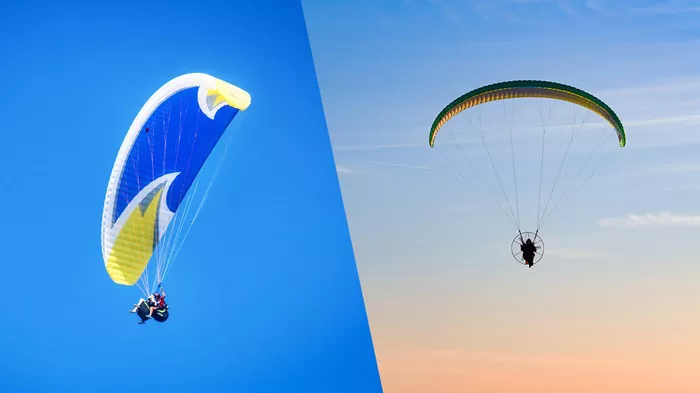Paragliding and paramotoring are both exhilarating sports that allow individuals to soar through the skies, experiencing the thrill of flight in a unique and personal way. However, despite their similarities, these two activities have distinct differences that set them apart. In this comprehensive guide, we will explore the key differences between paragliding and paramotoring, covering aspects such as equipment, techniques, safety, costs, and overall experience. Whether you are a beginner looking to take your first flight or an experienced pilot considering a new adventure, this article will provide you with the insights needed to make an informed decision.
What is Paragliding?
The Basics of Paragliding
Paragliding is a recreational and competitive sport involving the use of a lightweight, foot-launched glider aircraft. The pilot sits in a harness suspended below a fabric wing, which is shaped by the pressure of air entering vents in the front of the wing. Paragliders do not have an engine; they rely entirely on wind currents and thermals to stay aloft and navigate through the air.
Equipment Used in Paragliding
The primary equipment for paragliding includes:
Paraglider Wing: Made from high-strength fabric and suspension lines.
Harness: Provides support and comfort to the pilot.
Helmet: Essential for safety.
Variometer: Measures the rate of ascent or descent.
Reserve Parachute: A crucial safety device.
Techniques and Skills
Pilots must master various techniques, such as launching, turning, and landing. Skills in understanding weather conditions and using thermals effectively are also essential for extended flights and safety.
What is Paramotoring?
The Basics of Paramotoring
Paramotoring, also known as powered paragliding (PPG), combines paragliding with a small motor and propeller strapped to the pilot’s back. This motor provides thrust, allowing the pilot to take off from flat ground without the need for wind or thermals. Paramotoring offers greater control over flight duration and direction compared to traditional paragliding.
Equipment Used in Paramotoring
Key equipment for paramotoring includes:
Paramotor: A lightweight engine with a propeller.
Paraglider Wing: Similar to paragliding but often designed to handle the additional thrust.
Harness: Integrated with the paramotor for support.
Helmet: Often with communication systems.
Reserve Parachute: For emergencies.
Techniques and Skills
Paramotoring requires additional skills compared to paragliding, including engine management, understanding of thrust and torque, and maintenance of the paramotor. Pilots must also be proficient in standard paragliding techniques.
Key Differences Between Paragliding and Paramotoring
Launch and Takeoff
Paragliding: Requires a hill or mountain for launching. Pilots run down a slope to generate lift.
Paramotoring: Can take off from flat ground due to the motor’s thrust. Pilots use a short runway or open field.
Flight Control and Duration
Paragliding: Dependent on weather conditions and thermals. Flight duration can vary greatly.
Paramotoring: More control over flight duration and direction. The motor provides consistent thrust.
Accessibility and Training
Paragliding: Requires access to suitable launch sites. Training focuses on understanding weather and flight dynamics.
Paramotoring: More accessible as it can be done from various locations. Training includes engine management and maintenance.
Safety Considerations
Paragliding: Risks include weather changes and the need for emergency landing skills.
Paramotoring: Additional risks from engine failure and propeller-related injuries.
Costs Involved
Initial Investment
Paragliding: Typically lower cost, ranging from $3,000 to $6,000 for complete gear.
Paramotoring: Higher cost due to the engine, ranging from $5,000 to $10,000.
Maintenance and Operation
Paragliding: Lower ongoing costs, mainly for gear inspections and occasional replacements.
Paramotoring: Higher ongoing costs due to fuel, engine maintenance, and parts replacement.
see also: How Long Does A Paraglider Wing Last?
The Experience: Paragliding vs. Paramotoring
Paragliding: Pure Flight
Paragliding offers a pure, engine-free flight experience. Pilots feel a deep connection with the environment, relying solely on natural forces to stay aloft. The silence and simplicity of paragliding are often described as meditative and serene.
Paramotoring: Powered Adventure
Paramotoring provides an adventurous experience with the added thrill of engine power. Pilots enjoy greater freedom in choosing flight paths and durations, making it suitable for longer cross-country flights. The ability to take off from various locations adds to the sense of adventure.
Conclusion
Both paragliding and paramotoring offer unique and exhilarating ways to experience flight. Paragliding is ideal for those seeking a pure, minimalist connection with the sky, while paramotoring appeals to those looking for powered freedom and extended flight opportunities. Understanding the differences in equipment, techniques, safety, and costs can help aspiring pilots choose the right sport for their aerial adventures. Whether you choose to glide silently through the air or soar with the assistance of a motor, the skies await your exploration.
related topics:
- Winter Vs. Summer: Which Is The Best Season For Paragliding?
- How Do Most Paragliding Accidents Happen
- Paragliding Vs Skydiving: Which Is More Safer?

